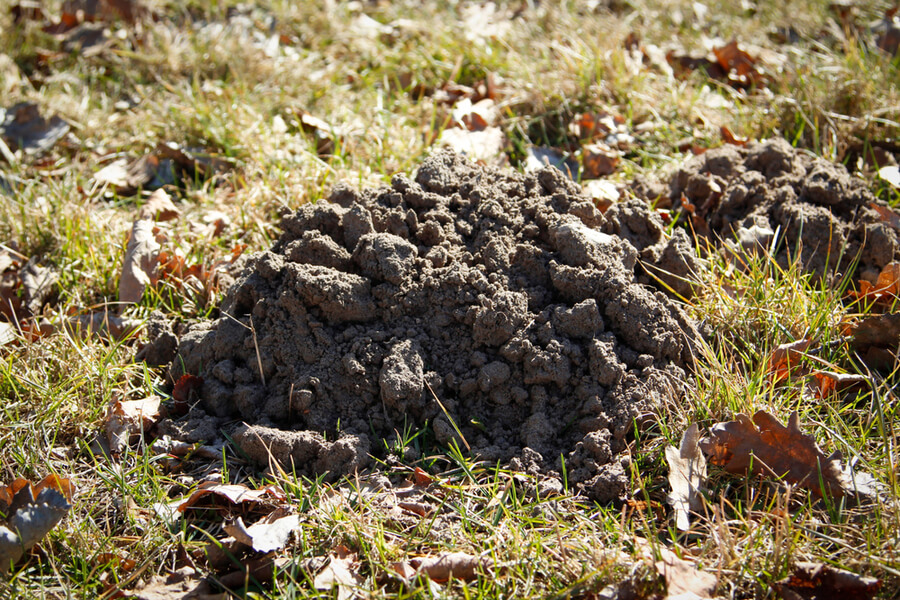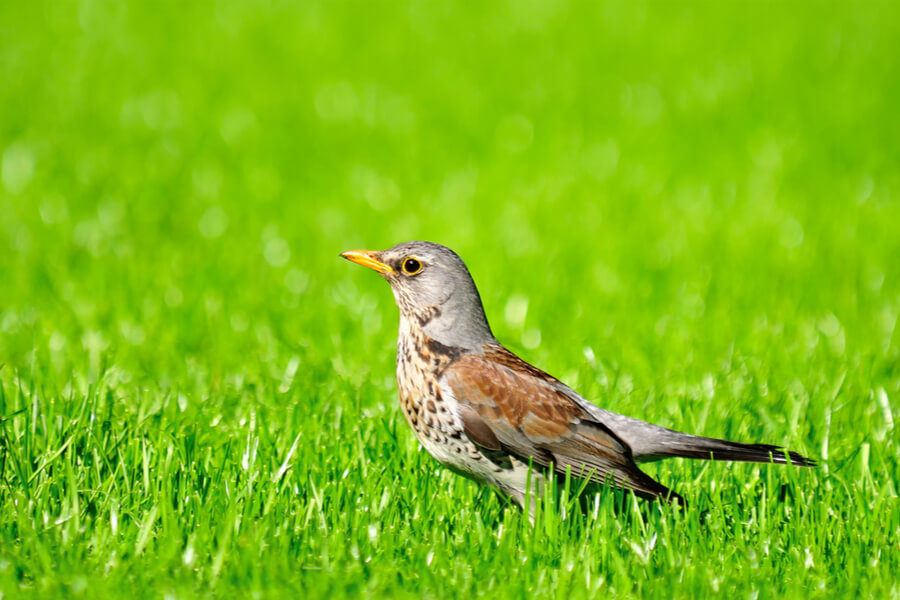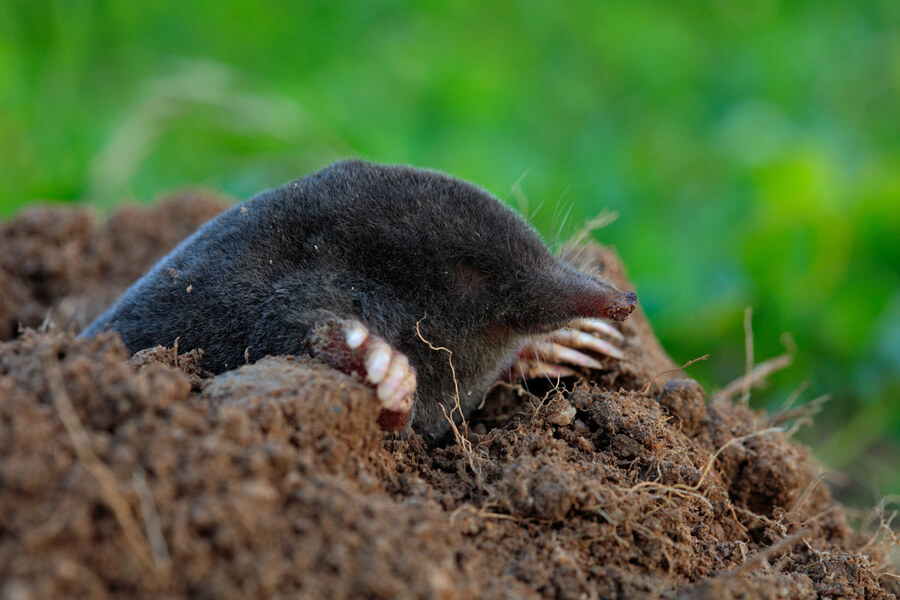Moles
 Moles are small, insect-eating mammals that live in subterranean tunnels. They hunt for food by expanding their tunnels and consuming the worms, insects, and invertebrates they pull from the ground. A lot of mole activity occurs after rain, when earthworms rise to the surface to soak up moisture. Mole dig tunnels very close to the surface of the ground, where their digging disrupts roots, grass, and soil.
Moles only dig underground, so you often won’t be able to actually see the holes moles create. Moles do often leave behind ridges in soil as they push it upward while looking for food, however. If you find trails of displaced dirt winding through your yard, it’s probably because moles tunneled beneath the surface. Moles also kill the root systems of the plants they tunnel beneath as they dig. If you have moles, you might notice winding lines of dead grass where they tunneled.
Moles are small, insect-eating mammals that live in subterranean tunnels. They hunt for food by expanding their tunnels and consuming the worms, insects, and invertebrates they pull from the ground. A lot of mole activity occurs after rain, when earthworms rise to the surface to soak up moisture. Mole dig tunnels very close to the surface of the ground, where their digging disrupts roots, grass, and soil.
Moles only dig underground, so you often won’t be able to actually see the holes moles create. Moles do often leave behind ridges in soil as they push it upward while looking for food, however. If you find trails of displaced dirt winding through your yard, it’s probably because moles tunneled beneath the surface. Moles also kill the root systems of the plants they tunnel beneath as they dig. If you have moles, you might notice winding lines of dead grass where they tunneled.
Voles
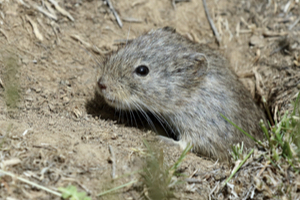 Also called field or meadow mice, voles are tiny mouse relatives that are excellent burrowers. Just like moles, voles spend so much time either underground or hiding that you’ll almost never see them. Voles largely subsist on the stems and blades of grass. They also burrow from the ground directly into the root systems of trees and other plants. Most of the digging they do happens when they’re trying to get at underground tubers or bulbs.
Unlike moles, voles don’t leave any mounds behind. Instead, they carve pathways through grass and other foliage by eating their way through it. They use these pathways to make their way through your yard to get at food and cover. You may also notice gnawing around the roots or bases of the plants in your yard. Voles are particularly fond of mulch, because it’s easy to dig through to get at root systems. If you notice disturbed mulch around your gardens, voles could be your culprit.
Also called field or meadow mice, voles are tiny mouse relatives that are excellent burrowers. Just like moles, voles spend so much time either underground or hiding that you’ll almost never see them. Voles largely subsist on the stems and blades of grass. They also burrow from the ground directly into the root systems of trees and other plants. Most of the digging they do happens when they’re trying to get at underground tubers or bulbs.
Unlike moles, voles don’t leave any mounds behind. Instead, they carve pathways through grass and other foliage by eating their way through it. They use these pathways to make their way through your yard to get at food and cover. You may also notice gnawing around the roots or bases of the plants in your yard. Voles are particularly fond of mulch, because it’s easy to dig through to get at root systems. If you notice disturbed mulch around your gardens, voles could be your culprit.
Groundhogs
 Groundhogs, also known as woodchucks, are a species of marmot that construct burrows in dry soil. Unlike moles or voles, they frequently venture out of their burrows, so you may actually see them in your yard. Groundhogs are solitary herbivores. They build burrows near their foraging ground and then never venture far from that territory. Groundhogs also use their burrows to hibernate and raise their young. Generally, groundhogs will abandon their burrows if threatened, but if cornered they can be dangerous.
Groundhogs may not tunnel or dig repeatedly like moles and voles, but they do create rather large burrows. Groundhog burrows can be 8 to 66 feet long, with winding chambers and multiple levels. These burrows can damage the surrounding plant life or even compromise the ground around them. Groundhogs build multiple exits out of their chambers. You may be able to spot these exits by finding piles of displaced dirt. Groundhogs move quite a bit of dirt to make their burrows, so these exits may be easily noticeable.
Groundhogs, also known as woodchucks, are a species of marmot that construct burrows in dry soil. Unlike moles or voles, they frequently venture out of their burrows, so you may actually see them in your yard. Groundhogs are solitary herbivores. They build burrows near their foraging ground and then never venture far from that territory. Groundhogs also use their burrows to hibernate and raise their young. Generally, groundhogs will abandon their burrows if threatened, but if cornered they can be dangerous.
Groundhogs may not tunnel or dig repeatedly like moles and voles, but they do create rather large burrows. Groundhog burrows can be 8 to 66 feet long, with winding chambers and multiple levels. These burrows can damage the surrounding plant life or even compromise the ground around them. Groundhogs build multiple exits out of their chambers. You may be able to spot these exits by finding piles of displaced dirt. Groundhogs move quite a bit of dirt to make their burrows, so these exits may be easily noticeable.
Skunks
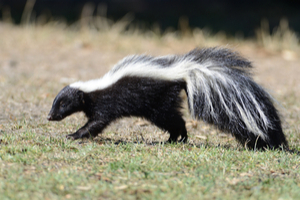 Skunks dig two different kinds of holes, for two different reasons. First, digging is the primary way skunks hunt for the grubs and lawn insects they feed on. When skunks dig to hunt for grubs, they create small, cone-shaped holes only a few inches deep. These are called “skunk holes”. Skunks dig skunk holes one at a time while searching areas for food systematically. You might see a growing series of skunk holes working their way across your lawn.
Skunks also dig burrows to live, raise their young, and hibernate. These burrows are smaller than groundhog burrows and usually only have one entrance. Skunks prefer to build these burrows beneath pre-existing structures such as decks, porches, or trees. The entrance to skunk burrows may peek out partially from beneath a structure. Skunks might also use an abandoned burrow or kick another animal out of their burrow instead. Skunks may react defensively if you startle them, so don’t approach skunk burrows if possible.
These are the most common animals that could dig up your lawn, but they aren’t the only ones. If your lawn damage doesn’t seem to match the descriptions here, don’t give up! No matter what pest happens to be digging up your lawn, there is a solution.
That solution? Varment Guard. Give us a call anytime you have lawn damage, and we’ll find the culprit and bring them to justice. Don’t let some pest rip up your hard work any more; call today!
Skunks dig two different kinds of holes, for two different reasons. First, digging is the primary way skunks hunt for the grubs and lawn insects they feed on. When skunks dig to hunt for grubs, they create small, cone-shaped holes only a few inches deep. These are called “skunk holes”. Skunks dig skunk holes one at a time while searching areas for food systematically. You might see a growing series of skunk holes working their way across your lawn.
Skunks also dig burrows to live, raise their young, and hibernate. These burrows are smaller than groundhog burrows and usually only have one entrance. Skunks prefer to build these burrows beneath pre-existing structures such as decks, porches, or trees. The entrance to skunk burrows may peek out partially from beneath a structure. Skunks might also use an abandoned burrow or kick another animal out of their burrow instead. Skunks may react defensively if you startle them, so don’t approach skunk burrows if possible.
These are the most common animals that could dig up your lawn, but they aren’t the only ones. If your lawn damage doesn’t seem to match the descriptions here, don’t give up! No matter what pest happens to be digging up your lawn, there is a solution.
That solution? Varment Guard. Give us a call anytime you have lawn damage, and we’ll find the culprit and bring them to justice. Don’t let some pest rip up your hard work any more; call today!

